"Stalin's holiday": Operation "Uranus"
Plan of operation
The idea of an offensive operation in the Stalingrad area was discussed at the Headquarters of the Supreme High Command in the first half of September 1942. “At this time,” writes Marshal A. M. Vasilevsky, “we were finishing the formation and training of strategic reserves, tank and mechanized units and formations, mostly armed with medium and heavy tanks; stocks of other military equipment and ammunition were created. All this allowed the Headquarters, already in September 1942, to draw a conclusion about the possibility and advisability of inflicting a decisive blow on the enemy in the very near future ... When discussing these issues at Headquarters, in which General G.K. Zhukov and I took part, it was determined that the planned counter-offensive should include two main operational tasks: one - to encircle and isolate the main group of German troops operating directly in the area of the city, and the other - to destroy this group.
After the war, the Stalingrad offensive operation, like any victory, had many fathers. N. Khrushchev claimed that together with the commander of the Stalingrad Front, A. I. Eremenko submitted to the Headquarters at the end of September a plan for a future counteroffensive. Eremenko himself said in his memoirs that he put forward the idea of Stalingrad counterattacks right on the day he was appointed front commander. We can say that in the second half of September the idea of a counteroffensive was in the air. Admiral fleet N. G. Kuznetsov pointed out the real author who took responsibility for the implementation of the plan: “It must be said bluntly that, with the huge and sometimes decisive importance of the role of commanders who carried out the operation’s plans, the origin of the idea at Headquarters was determined and the will of the Supreme Commander battle success. "
The plan of the offensive, which received the conditional name "Uranus", was distinguished by the courage of the plan. Southwest offensive. The Don and Stalingrad fronts were to unfold on an area of 400 square. km The troops making the maneuver according to the enemy’s surroundings had to fight the distance to 120 - 140 km from the north and to 100 km - from the south. They planned to create two fronts of encirclement of the enemy grouping - internal and external.
“The direction of the Russian strikes,” writes the German general and military historian Kurt Tippelskirkh, “was determined by the very outline of the front line: the left flank of the German group stretched almost 300 km from Stalingrad to the Don bend in the area of Novaya Kalitva, and the short right flank, where particularly weak strength, began at Stalingrad and was lost in the Kalmyk steppe ".
Large forces were concentrated on the Stalingrad direction. The Southwestern Front was reinforced with two tank (1st and 26th) and one cavalry (8th) corps, as well as a number of tank and artillery formations and units. The Stalingrad front was reinforced by the 4th mechanized and 4th cavalry corps, three mechanized and three tank brigades. The Don Front received three rifle divisions for reinforcement. In just a relatively short period (from October 1 to November 18), four tank, two mechanized and two cavalry corps, 17 separate tank brigades and regiments, 10 rifle divisions and 6 brigades, 230 artillery and mortar regiments. Soviet troops included about 1135 thousand people, about 15 thousand guns and mortars, over 1,5 thousand tanks and self-propelled artillery pieces. The composition of the air force of the fronts was brought to 25 aviation divisions with over 1,9 thousand combat aircraft. The total number of estimated divisions in three fronts reached 75. However, this powerful grouping of Soviet troops had a peculiarity - about 60% of the personnel of the troops were young replenishment, who did not yet have combat experience.
As a result of the massing of forces and means in the directions of the main attacks of the South-Western and Stalingrad fronts, a significant superiority of the Soviet troops over the enemy was created: in people - 2-2,5 times, artillery and tanks - 4-5 times and more. The decisive role in striking was assigned to the 4 tank and 2 mechanized corps.
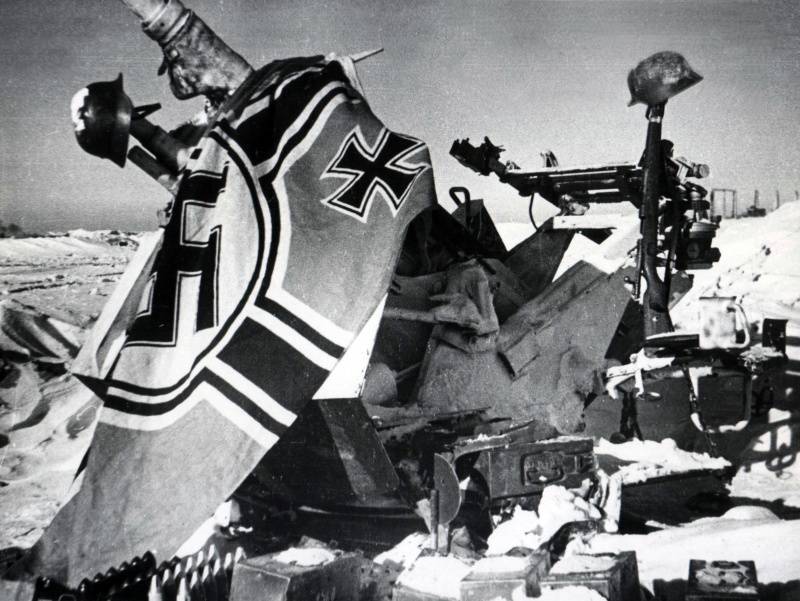
German anti-aircraft battery captured by fighters of the Soviet 21 Army near Stalingrad
In early November, Army General G. K. Zhukov, Colonel-General A. M. Vasilevsky, Colonel-General Artillery N. N. Voronov, and other representatives of Headquarters arrived in the Stalingrad area again. Together with the command of the fronts and armies, they had to carry out preparatory work directly on the ground for the implementation of the Uran plan. November 3 Zhukov held a final meeting with the troops of the 5 Tank Army of the South-Western Front. In addition to the command of the front and the army, corps and division commanders, whose troops were intended to attack in the direction of the main attack, took part in it. On November 4, the same meeting was held in the 21 Army of the South-Western Front with the participation of the commander of the Don Front. 9 and 10 November meetings were held with army commanders, formation commanders and the command of the Stalingrad Front.
In the northern sector of 5, the tank and 21 armies of the Southwestern Front, under the command of N. F. Vatutin, which had dealt the main blow, were to attack from the bridgehead south-west of Serafimovich and from the Kletskaya area, they should break through the defense of the 3 Romanian army and develop an offensive in the south-east in the general direction of Kalach. The troops of the Don Front under the command of K. K. Rokossovsky - part of the 65 (former 4 tank) and 24 armies - delivered auxiliary strikes in the general direction of the farm Vertyachy with the aim of surrounding the enemy forces in the small bend of the Don and cutting them off the main German grouping in the Stalingrad area. The strike force of the Stalingrad Front, under the command of A.I. Eremenko (51, 57, and 64), was tasked with deploying an offensive from the Sarpa, Tsatsa, Barmantsak lakes in the north-west direction to join the Southwestern troops. front.
Support for the advancing troops was provided by: on the South-Western Front - 2-I and 17-I Air Forces, on the Stalingrad - 8-I Air Forces, on Don - 16-I Air Forces. Stalin attached special importance to air preparation operations. On November 12, the Supreme delivered to Zhukov that if the air preparation of the operation on the Stalingrad and South-Western Fronts is unsatisfactory, then the operation will end in failure. The experience of war shows, he noted, that the success of an operation depends on air superiority. Soviet aviation must accomplish three tasks: 1) concentrate its actions in the area of attack of attack units, suppress German aircraft and firmly cover its troops; 2) make way for the advancing units by systematically bombing the German forces standing against them; 3) pursue the retreating enemy troops by systematic bombing and assault actions in order to completely upset them and prevent them from gaining a foothold in the nearest defensive lines. Much attention was paid to strengthening the air armies of the fronts. In November, the 17-th mixed air corps arrived from the Reserve Stakes in the 1-th Air Army, the 8-th mixed Air Corps came to the 2-th Air Army. It was also decided to use large long-range aviation forces during the counteroffensive.
The attack groups of the Soviet troops, concentrated north and south of Stalingrad, were to crush the flanks of the Stalingrad enemy group and close the circle around it in the area of Sovetsky, Kalach by a sweeping movement. After the destruction of the Stalingrad enemy group, our troops were to develop success towards Rostov, defeat the German troops in the North Caucasus, and launch an offensive in the Donbass, in the Kursk, Bryansk and Kharkov directions.
The Soviet command, which widely applied methods of camouflage and disinformation, this time managed to mislead the enemy about the place, time of impact and the forces with which it was supposed to inflict. So, just to trick the German aerial reconnaissance, 17 bridges were built in various places, but only 5 was actually intended to be used. As previously noted, the enemy did not expect a large-scale Russian offensive in the area of Stalingrad. The greatest threat was seen against the Army Group Center. The High Command of the Ground Forces (OKH) discussed the possibility of a winter offensive by the Russian troops against the Rzhevsky bulge; also the probability of the Russian offensive against the northern flank of Army Group “B” with access to Rostov and the Sea of Azov. The command of the 6 Army and Army Group “B” monitored the concentration of Soviet forces in the bridgeheads of Kletskaya and Serafimovich, predicted the enemy would soon advance in their own zone, but underestimated its scale. So, despite reports of Russian preparations for an offensive, the OKH ordered to continue the offensive to capture Stalingrad, contrary to the objections of the commander of the 6 army. Most of the staff generals agreed that the Russians had no forces to inflict powerful blows, that the enemy was drained of the battles in Stalingrad, and in this they miscalculated very large.
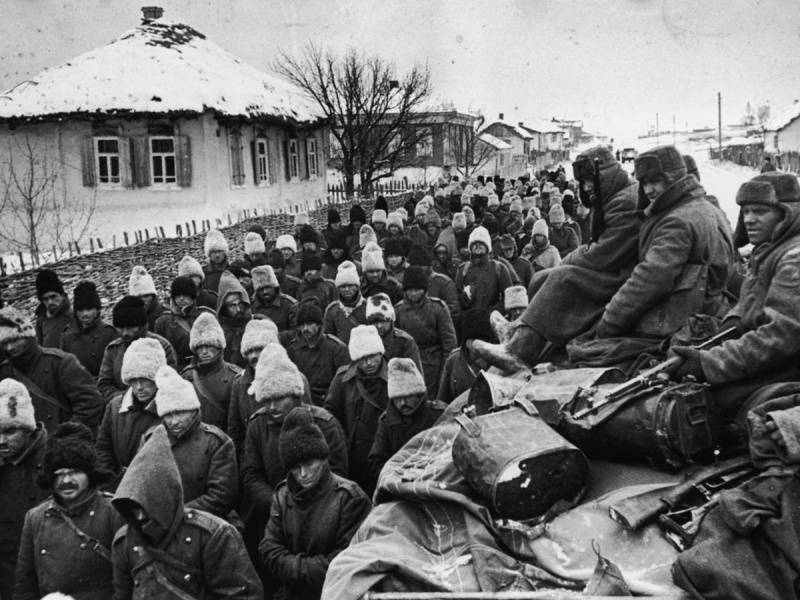
A column of Romanian soldiers captured at Stalingrad, moving past the truck with the Red Army
Thus, even if the enemy command at Stalingrad in the autumn of 1942 began to notice signs of the impending attack of the Soviet troops, it did not have a clear idea about the scale of it, nor about the time, nor about the composition of the strike groups, nor about the direction of the main attacks. Located far from the front, the supreme command of the German forces was even less able to correctly assess the true dimensions of the danger threatening its Stalingrad group.
Colonel-General Jodl, chief of staff of the operational leadership of the OKW (Supreme Command of the Wehrmacht), subsequently acknowledged the complete surprise of the Soviet offensive for the high command: “We completely saw the concentration of large Russian forces on the flank of the 6 Army (on the Don). We absolutely had no idea about the strength of the Russian troops in the area. Previously, there was nothing here, and suddenly a big force was struck, which was of decisive importance. ” The surprise factor has become an important advantage of the Red Army.
Relying on the capture of Stalingrad at any cost and by assigning more and more new terms for this, the high command spent their reserves in these attempts, almost lost the opportunity to radically strengthen the position of their troops on the southern strategic flank. In mid-November, the enemy had only six divisions in the Stalingrad area as operational reserves, which were scattered on a broad front. The command of Army Group "B" began to withdraw some divisions to the reserve, planned to regroup the troops of the 6 and 4 tank armies in order to create a deeper operational structure and strengthen the flanks of their grouping. The 48-th German tank division in the area of Perelazovsky and the 22-th Romanian tank division were taken to the reserve and subordinated to the 1-th tank corps for the 3-th Romanian army at the turn of the r. Chir in Chernyshevskaya area. South of Stalingrad, the 4-I Romanian army was redeployed to the east of Kotelnikovo in early October (originally its divisions were part of the German 4-tank army) in order to strengthen the right flank of the Stalingrad group. But these measures were too late and insufficient to change the situation radically.
Breakthrough Enemy Defense
19 November. 19 November 1942. The offensive forces of the South-Western and right wing of the Don Fronts launched an offensive. The breakthrough of the enemy’s defense was carried out simultaneously in several sectors. The weather was foggy, non-flying. Therefore, we had to abandon the use of aviation. In 7 hours 30 minutes with a volley of rocket launchers - the "Katyusha" - artillery preparation began. 3500 guns and mortars smashed the enemy's defenses. One hour was fired for destruction and twenty minutes for repression. Artillery preparation caused great damage to the enemy.
In 8 hours of 50 minutes, the infantry divisions of the 5 tank army P.L. Romanenko and the 21 army I.M. Chistyakov together with the tanks of direct infantry support went on the attack. In the first echelon of the 5 tank army there were 14-I and 47-I guards, 119-I and 124-rifle divisions. Despite the powerful artillery training, at first the Romanians stubbornly resisted. The enemy’s firing points remaining unsuppressed seriously slowed the movement of our troops. By 12 hours, breaking the first position of the main line of the enemy’s defense, the Soviet divisions advanced only 2 - 3 km. Then the army commander decided to enter into the battle echelon of success development - the 1 and 26 tanks. The defense of the enemy was still not broken, and there was no gap for entering the breakthrough of mobile units. Tank formations overtook the infantry and broke through the defenses of the enemy with a powerful blow. Romanian troops ran, began to surrender. The enemy’s rear line was overcome immediately.
Thus, the mobile group of the 5 tank army — the 1 and 26 tank corps — by the middle of the first day of the offensive completed the breakthrough of the enemy’s tactical defense and developed further actions in the operational depth, paving the way for the infantry. In the resulting gap (16 km along the front and in depth), the 8 Cavalry Corps was introduced in the second half of the day.
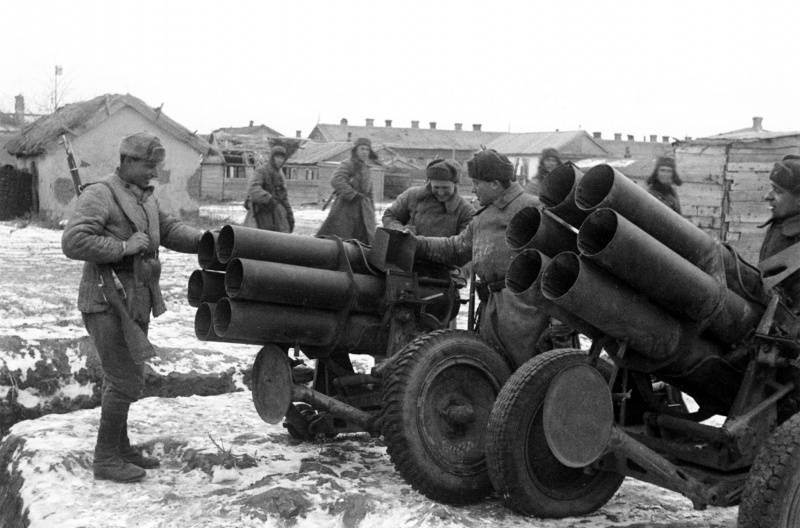
Gunners - Guards inspect captured German 150-mm six-barreled mortar "Nebelverfer" 41 (15 cm Nebelwerfer 41) on the Stalingrad front
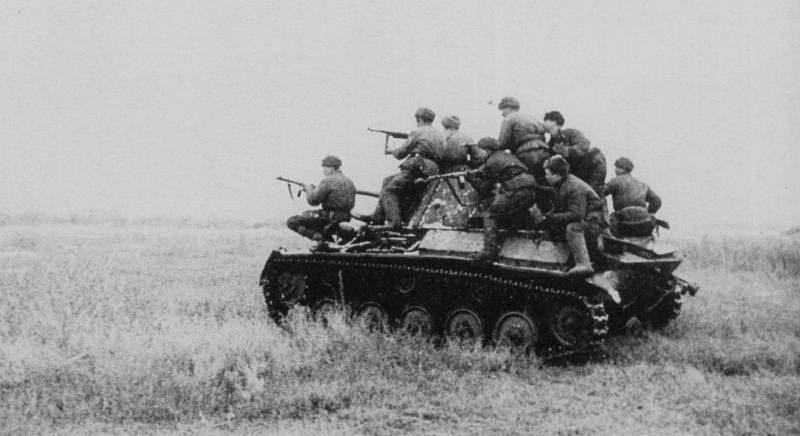
Soviet light tank T-70 with troops on armor on the Stalingrad front
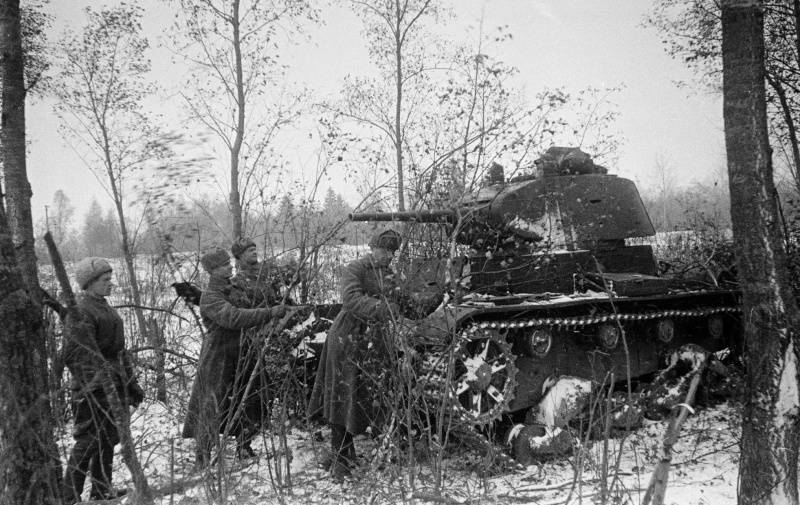
Soviet soldiers at the T-26 tank on the outskirts of the liberated village near Stalingrad
The enemy resisted entering operational reserves into battle. The 1-I Romanian tank division (it had only light Czechoslovak and French trophy tanks) from the Perelazovsky region was sent to the front to help its infantry divisions. In addition, the enemy command sent 7 th cavalry, 1 th motorized and 15 th infantry divisions to Pronin, Ust-Medvedetsky, Nizhne-Fomikhinsky, than temporarily delayed the advancement of Soviet units here. The enemy’s stubborn resistance to the front of the 14 Guards Rifle Division created a threat to the right flank of the 5 Tank Army and delayed the advance of the left flank of the 1 Guards Army.
The 21 Army was advancing from the Kletskaya area on the 14 km front. In the first echelon of the army, the 96, 63, 293 and 76 rifle divisions advanced. The enemy here again offered stubborn resistance: the 96 and 63 divisions of the infantry advanced slowly. More successfully acted on the direction of the main attack 293-I and 76-I infantry divisions. The commander of the 21 Army Chistyakov also used his mobile units to complete the breakthrough of the enemy defense. The mobile group of the 4 tank and 3 guards cavalry corps was thrown into the attack.
The 4 Tank Corps under the command of Major General Tank Forces A.G. Kravchenko moved in two echelons, on two routes and decided to break through the enemy defenses. The right column of the 4 tank corps as part of the 69 and 45 tank brigades on the night of November 20 entered the Pervomaysky state farm, Manoilin, and broke through 30-35 km. The left corps of the corps as part of the 102 tank and 4 motorized rifle brigades by the end of November 19, moving to the depth of 10-12 km, reached the area of Zakharov, Vlasov, where they met stubborn resistance of the enemy.
The 3 Guards Cavalry Corps under the command of Major General I. A. Pliev, leading battles with the departing enemy, advanced in the direction of Verkhne-Buzinovka, Evlampievsky, Bolshenabatovsky. In his memoirs, the former commissar of the 3 Guards Cavalry Corps, Colonel D. S. Dobrushin writes: “The 32-I and 5-I cavalry divisions were in the first echelon, the 6-I Guards - in the second. The order of the corps commander was to go around the enemy’s resistance centers - they either cease to exist or will be destroyed by the infantry following the cavalry. On the line of the villages of Lower and Upper Buzinovka, the enemy, trying to restrain the advance of our units, opened heavy artillery and mortar fire. The artillery of the advancing units, deployed, took up firing positions. The artillery duel began. ” General Pliev decided to bypass the Nizhne-Buzinovka from the south with parts of the 6 Guards Cavalry Division and attack the enemy from the rear. “Shelves at the trot came out in predetermined directions. At that time, the 5 and 32 cavalry divisions, together with the T-34 tanks, were moving from the front to the enemy trench line. The battle lasted for two hours. The commander of the neighboring army, General Kuznetsov, arrived and began to express his displeasure at the fact that the corps was marking time. At this time, soldiers began to jump out of the enemy's trenches in disarray. This horsemen hit from the rear. Soon the defense of the enemy was pierced to the full depth. "
As a result, mobile units of the strike force of the South-Western Front completed a breakthrough of the enemy defense and began to move south into the enemy’s operational depth, smashing its reserves, headquarters and outgoing units. At the same time, infantry divisions, advancing behind mobile units, completed the cleansing of populated areas and captured the remnants of defeated enemy troops. Our troops advanced on 25 - 35 km, broke through the defense of the Romanian 3 Army in two sectors: south-west of Serafimovich and in the area of Kletskaya. The Romanian 2 and 4 army corps were routed, and their remnants with the 5 army corps were covered from the flanks.
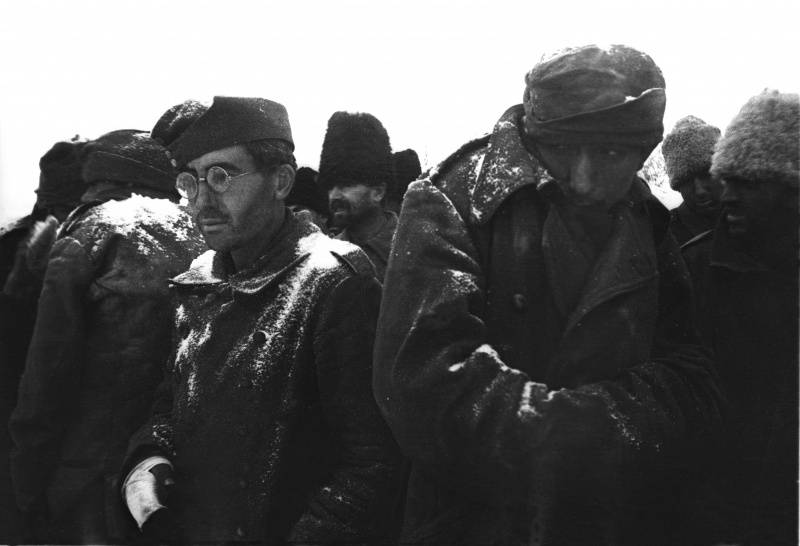
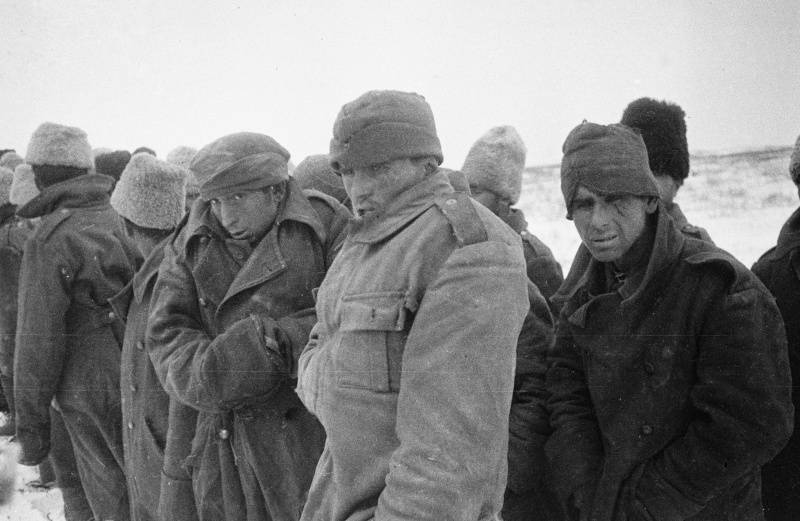
Romanian prisoners of war taken prisoner in the area of the village of Raspopinskaya near the city of Kalach
Don front. The troops of the Don Front 19 November also launched an offensive. The main attack was inflicted by the 65 Army units under the command of P.I. Batov. In 7 hour. 30 min. heavy guards mortar regiments launched the first salvo. In 8 hour. 50 min. went on the attack infantry. The enemy offered stubborn resistance, counterattacked. Our troops had to overcome strong enemy resistance in areas that were inaccessible to the advancing terrain. “Let the reader imagine this area: winding deep ravines rest on the chalk cliff, its steep walls rise to 20-25 meters. Hand almost nothing to hold on. Feet glide over the soaked chalk. ... It was evident how the soldiers ran up to the cliff and climbed up. Soon the whole wall was covered with people. They broke down, fell, supported each other and stubbornly crawled upwards. ”
By the end of the day, the troops of the 65 Army, by their right flank, advanced into the depth of the enemy's position to 4 - 5 km, without breaking the main line of his defense. 304-rifle division of the army after a stubborn battle took Melo-Kletsky.
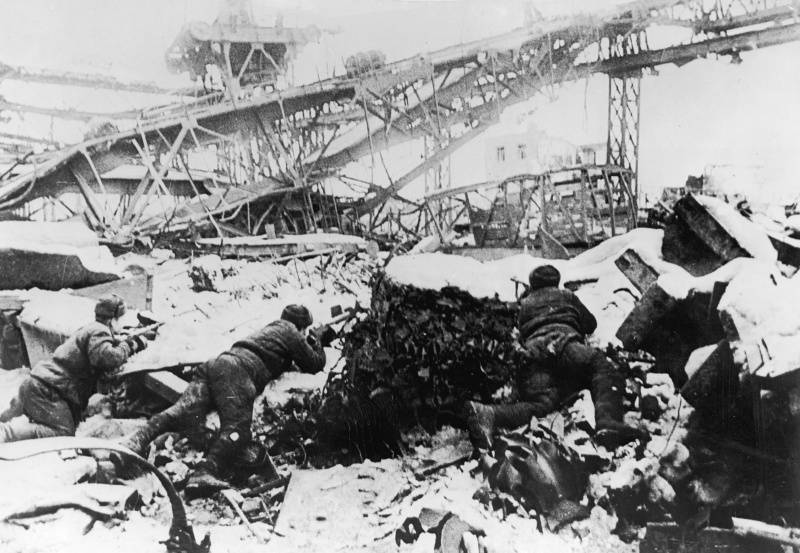
Soviet soldiers in the battle for the plant "Red October" during the Battle of Stalingrad. November 1942
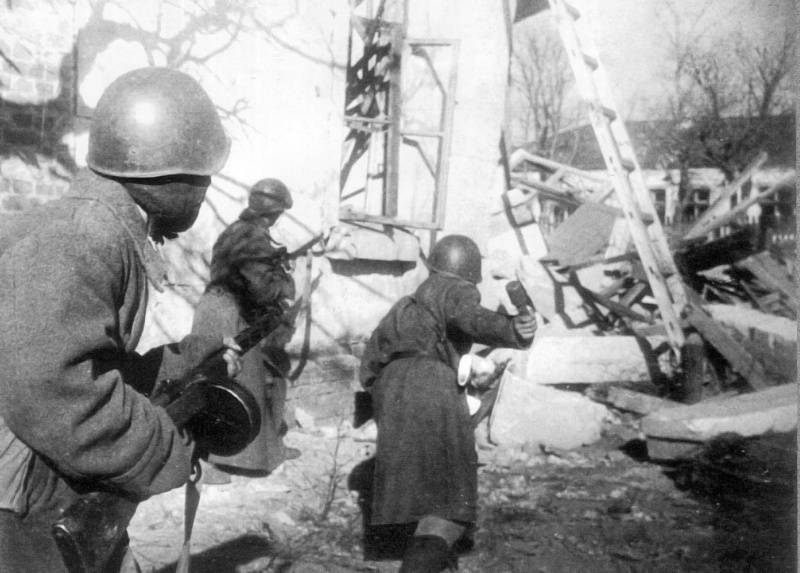
The assault team of the 13 Guards Division is cleaning the houses in Stalingrad
To be continued ...
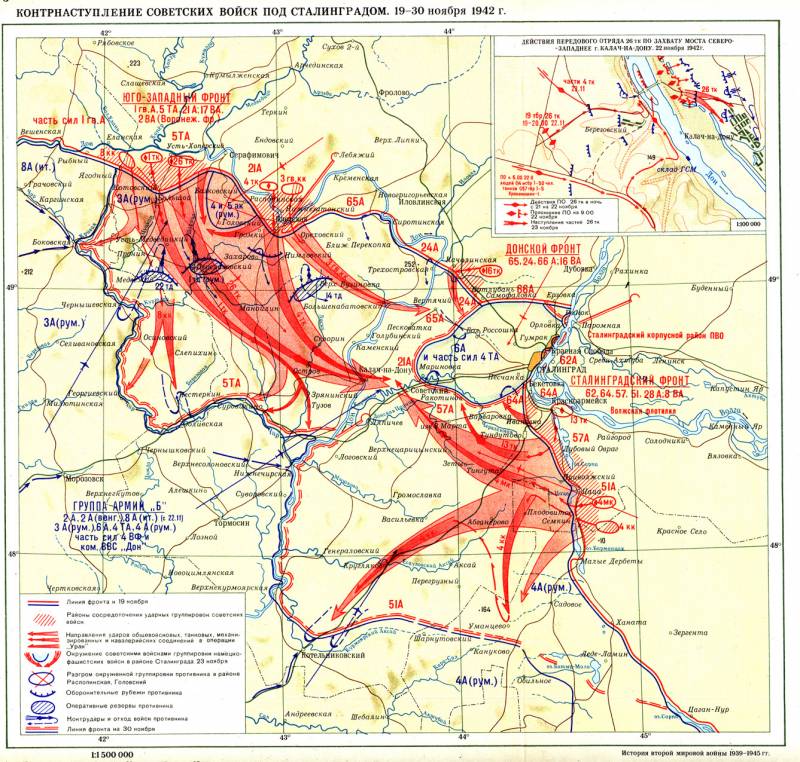
Information